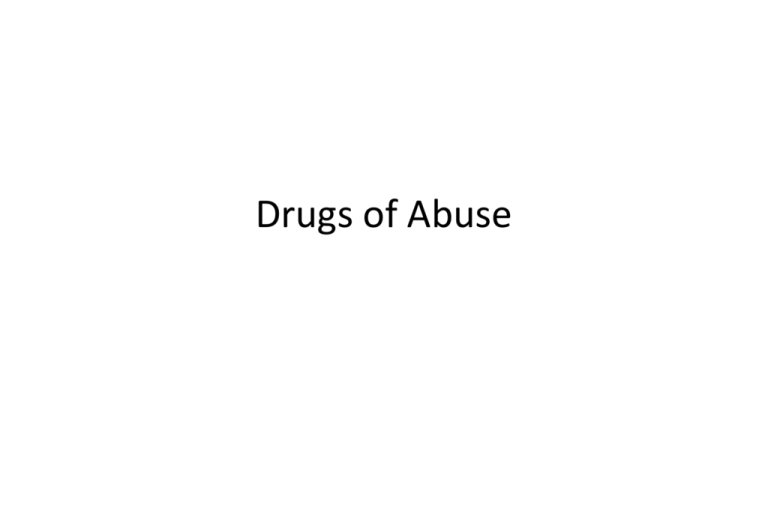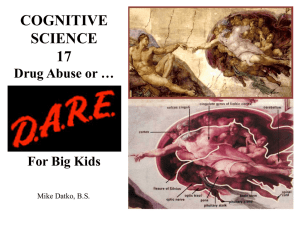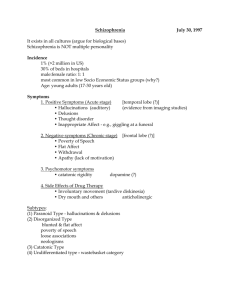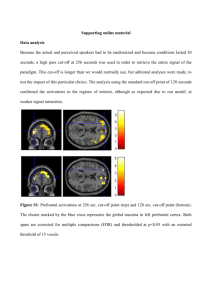Drugs of Abuse
advertisement

Drugs of Abuse Americans’ Views of the Seriousness of Health Problems % saying “very serious problem” (Top 10 of 36 Problems) Drug abuse 82% Cancer 78% Drunk driving 75% Heart disease 74% HIV/AIDS 73% Violence Child abuse Smoking 71% 69% 68% Alcohol abuse 65% Stress 65% Harvard School of Public Health/Robert Wood Johnson Foundation/ICR, August 2000 Two Decades of Neurobiological Research Have Brought Us A New Understanding of Drug Abuse and Addiction, Their Complexity and their Solutions For Example… We Know That Despite Their Many Differences, Virtually All Abused Substances Enhance Dopamine (neurotransmitter) Activity (particularly related to pleasure, motor, and cognitive function • Other pathways also involved! Dopamine Pathways striatum frontal cortex Functions •reward (motivation) •pleasure,euphoria •motor function (fine tuning) •compulsion •perserveration •decision making hippocampus substantia nigra/VTA Serotonin Pathways nucleus accumbens raphe Functions •mood •memory processing •sleep Neuronal structure (receiving) (sending) stimulation vesicle Neuronal terminal Drug : transporter • cocaine • ritalin Vmat /serotonin How some drugs of abuse cause dopamine release: • opioids narcotics (activate opioid receptors) DA/5HT • nicotine (activate nicotine receptors) • marijuana (activate cannabinoid receptors) • caffeine • alcohol (activate GABA receptors; an inhibitory transmitter) transporter Vmat • Release DA from vesicles and reverse transporter Drug Types: • Amphetamines -methamphetamine -MDMA (Ecstasy) serotonin/ DA/5HT Accumbens 1100 1000 900 800 700 600 500 400 300 200 100 0 AMPHETAMINE Much greater DA Activity thanDOPAC any HVA Other drug of abuse -causes neurotoxicity 1 2 3 4 % of Basal Release 400 0 250 Accumbens Caudate 150 100 % of Basal Release 200 DA DOPAC HVA 100 250 NICOTINE COCAINE 200 0 5 hr Accumbens 300 Time After Amphetamine % of Basal Release % of Basal Release Effects of Drugs on Dopamine Release 0 1 2 3 4 Time After Cocaine Accumbens 5 hr ETHANOL Dose (g/kg ip) 200 0.25 0.5 1 2.5 150 100 0 0 1 2 3 hr 0 Time After Nicotine Source: Di Chiara and Imperato 0 1 2 3 Time After Ethanol 4hr Natural Rewards Elevate Dopamine Levels 200 % of Basal DA Output NAc shell 150 100 Empty 50 Box Feeding SEX 200 150 100 15 10 5 0 0 0 60 120 Time (min) 180 ScrScr BasFemale 1 Present Sample 1 2 3 4 5 Number 6 7 8 Scr Scr Female 2 Present 9 10 11 12 13 14 15 16 17 Mounts Intromissions Ejaculations Source: Di Chiara et al. Source: Fiorino and Phillips Copulation Frequency DA Concentration (% Baseline) FOOD Implication: Elucidation of the mechanism of drug addiction will help to understand other addictive and motivational behaviors/disorders Addiction and tolerance can be synonymous Pharmacodynamic mechanism of Tolerance Induction of Tolerance to Morphine Brain Circuits Involved in Drug Addiction INHIBITORY CONTROL OFC PFC ACG Hipp SCC MOTIVATION/ DRIVE (saliency) REWARD NAcc VP Amyg MEMORY/ LEARNING Reward Pathways: Role of Opioids HOW DOES ADDICTION OCCUR? • Principles of Behavior Dynamics Behavior Tracts Compete for Expression Prefrontal Cortex A B C behavior expressed C B dopamine initiated Orbitofrontal cortex Expression is Determined by (i) Dominance of Tracts, (ii) Strength of Prefrontal Cortex to Select, (iii) Relevance or saliency (orbitofrontal cortex) Activation of Dopamine reward pathway initiates a behavior track (Miller & Cohen, Annu. Rev. Neurosci. 24 [2001] 167) • Principles of Behavior Dynamics Prefrontal Cortex Orbitofrontal cortex C A Addiction B B BB behavior expressed dopamine How does a behavior become an addiction? B We Have Generated A Lot of Evidence Showing That… Prolonged Drug Use Changes the Brain and In Fundamental and Long-Lasting Ways AND… We Have Evidence That These Changes Can Be Both Structural and Functional BRAIN IMAGING Positron Emission Tomography Magnetic Resonance Imaging Decreases in Metabolism in Orbito Frontal Cortex (OFC) control cocaine abuser Volkow et al. Am. J. Psychiatry 148, 621 METH Suppresses Expression of DAT (note: duration of use/3-20 yrs; abstinent/ 1-4 yrs) Source: McCann U.D. et al., The Journal of Neuroscience, 18(20), pp. 8417-8422, October 15, 1998. Dopamine Transporter Loss After Heavy Methamphetamine Use (PET analysis) Comparison Subject METH Abuser Source: Volkow, N.D. et al., Am J. Psychiatry, 158(3), pp. 377-382, 2001. Dependence of Verbal Memory on Striatal DAT Interference recall Delayed recall Compromises Cognitive Functions R = 0.70 p < 0.005 Source: Volkow, N.D. et al., Am J. Psychiatry, 158(3), pp. 377-382, 2001. R = 0.64 p < 0.01 MOTOR FUNCTION • Slowed gait •Impaired balance • Impairment correlates with damage to dopamine system Implication: Brain changes resulting from prolonged use of psychostimulants, such as methamphetamine may be reflected in compromised cognitive and motor functioning Is There Recovery? • Good News: After 2 years some of the dopamine deficits are recovering • Bad News: Functional deficits persist • What does this mean??? Reward System in Addiction More Cocaine Alcohol Food treated METH Ability to Experience Rewards Is Damaged Less Their Brains… Get Rewired by Drug Use INHERITED FACTORS (genetic vulnerability-not inevitability) • Common strategy to investigate are Twin Studies In General: Inheritability for Drug Abuse Ranges From 40-60% • Some Variability Between Drugs • Some Gender Variability Chromosomal Locations for Substance Abuse Vulnerability Loci 17 5 6 r-SA 3 samples, > 2 labs 4 samples, > 3 labs r-candidate >2 samples, >2 labs Uhl et al Tr Genetics, updated June 03 22 Complex genetics Complex phenotypes (expressions) (Relation to Risk Factors?) VULNERABILITY to What? Starting Drug Use? Liking Drugs More? Continuing Drug Use? Becoming Addicted? Specific to A Particular Drug? For ExampleContribution of Genetic Factors to: Nicotine- •Liability to initiate=56% • Transition to dependence=70% • Smoking persistence= >50% (Lerman & Berrettine, Amer. J. Med. Gen. 54 (2003) 48) Genetics May Influence How Neurobiology Interacts With Environment Genetics Gene/ Environment Interaction Environment PET Images: Dopamine Receptor Density More likely to selfadminister Cocaine Addictive Disorders Often Co-Exist with or Predispose to Mental Disorders DSM IV Manual: Devotes ~ 100 pages to describing addiction and dependence disorders Discusses substance abuse as a confound to diagnosis and Tx National Comorbidity Survey (NCS) Nearly half of individuals with a past year substance use disorder also had a mental disorder Mental disorders found to be most prevalent included affective disorders, anxiety disorders, personality disorders, and psychotic disorders (Note: can we have parity for mental health without considering drug abuse?) Common Underlying Neurobiological Factors Can Be: Neurochemical (imbalance of neurotransmitters) Structural/anatomical (same regions and pathways) Genetic (inherited factors that compromise function) Because of this overlap, drugs of abuse can cause symptoms that mimic most forms of mental illness Drug Cocaine and Methamphetamine Disorder Schizophrenia, paranoia, anhedonia, compulsive behavior Stimulants Anxiety, panic attacks, mania and sleep disorders LSD, Ecstasy & psychedelics Delusions and hallucinations Alcohol, sedatives, sleepaids & narcotics PCP & Ketamine Depression and mood disturbances Antisocial behavior Some drugs of abuse have a mechanism of action similar to that of drugs used as psychotherapeutic agents Significance: rationale for self-administration Synaptic vesicle Serotonin/dopamine synaptic terminal transporter Prozac, Ritalin, & Cocaine block Postsynaptic target Causes an effect Activate transmitter receptors Mechanism of action of amphetamine and cocaine Chronic use of some of these drugs of abuse may alter the way the brain functions, making persons particularly susceptible to mental illness People With Comorbid Mental and Addictive Disorders Have a Double Double Brain Disease Mental Disorder Comorbid Disorders Addictive Disorder Role of Stress and Trauma The Stress Hormone Cycle Hypothalamus CRF Pituitary Gland ACTH CRF: Corticotropin Releasing Factor Adrenal Glands Kidneys Stress Responses Stress Responses Stress StressResponses Responses CORTISOL Anxiety DRUG USE (Self-Medication) CRF What Role Does Stress Play In Initiating Drug Use? STRESS CRF Anxiety Anxiety Prolonged What DRUG USE RELAPSE Happens When A Person Stops CRF Taking A Drug? Abstinence Stress Reliably Reinstates Drug Seeking in Rats Responses Cocaine-trained rats 100 80 60 40 Alcohol-trained rats * Inactive Lever Active Lever * * * 20 0 Saline Cocaine Footshock Responses Nicotine-trained rats Water Alcohol Footshock Heroin-trained rats 100 80 60 40 * * * * 20 0 Saline Nicotine Footshock Saline Heroin Footshock From: Psychopharmacology, 1996, 1998, 1999 ; J. Neurosci. 1996 CRF1 Receptor Antagonist Attenuates Stress-Induced Reinstatement of Drug Seeking Heroin-trained rats Alcohol-trained rats 45 30 15 0 Responses (3 hr) 60 * Responses (1 hr) 60 Cocaine-trained rats No stress Intermittent Footshock 45 * 30 * * 15 * 0 0 15 30 0 15 30 0 15 CP-154,526 Dose (mg/kg, SC) From: Shaham et al. Psychopharmacology 1998; Le et al. Psychopharmacology, 2000 30 Objectives of Intervention: • Rearrange dominance of behavior tracks contingency management (vouchers) motivational enhancement therapeutic communities • Principles of Behavior Dynamics Prefrontal Cortex A B C behavior expressed dopamine initiated Orbitofrontal cortex C B • Strengthen prefrontal cortex influence (change thinking process) cognitive and cognitive behavioral tx (unlearn old habits-suppress; learn new skills) assertiveness training (suppress and express) • Principles of Behavior Dynamics Prefrontal Cortex A B C behavior expressed dopamine initiated Orbitofrontal cortex C B •Alter function of orbitofrontal (saliency) cortex motivational therapy family therapies • Principles of Behavior Dynamics Prefrontal Cortex A B C behavior expressed dopamine initiated Orbitofrontal cortex C B • Recovery of function (frontal and obitofrontal cortex) all treatments that keep brain away from drugs for extended time • Principles of Behavior Dynamics Prefrontal Cortex A B C behavior expressed dopamine initiated Orbitofrontal cortex C B • Alleviate underlying psychiatric disorder administer: Antidepressants for depression Ritalin for ADHD Sedatives for anxiety Targets of Medication • Methadone, LAAM and Buprenorphine Activate opioid receptors • Naloxone Block opioid receptors • Nicotine gum/patch Activate nicotinic receptors stimulation Vmat vesicle Neuronal terminal transporter How some drugs of abuse cause dopamine release: • opioids narcotics (activate opioid receptors) • nicotine (activate nicotine receptors) DA • Psychostimulants Enhancing GABA-ergic inhibition (baclofen-muscle relaxant; anti-seizureTiagabine) Cannabinoid antagonist (rimonabant) • Principles of Behavior Dynamics Prefrontal Cortex GABA and cannabinoid systems critical for A function B C behavior expressed dopamine initiated Orbitofrontal cortex C B • Relieve stress-related drug abuse CRF antagonist Anxiety Prolonged DRUG USE CRF Abstinence RELAPSE No cure







